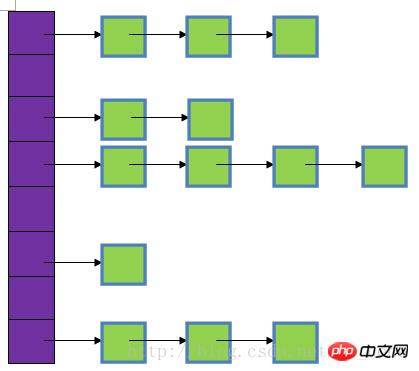Home >Java >javaTutorial >HashMap source code analysis
HashMap source code analysis
- 巴扎黑Original
- 2017-06-26 09:57:081369browse
1. Overview of HashMap
HashMap is based on the implementation of the Map interface of the hash table. This implementation provides all optional mapping operations and allows null values and null keys. (The HashMap class is much the same as a Hashtable except that it is not synchronized and allows null .) This class does not guarantee the order of the map, and in particular it does not guarantee that the order is immutable.
It is worth noting that HashMap is not thread-safe. If you want a thread-safe HashMap, you can obtain a thread-safe HashMap through the static method synchronizedMap of the Collections class.
Map map = Collections.synchronizedMap(new HashMap());
2. The data structure of HashMap
The bottom layer of HashMap is mainly implemented based on arrays and linked lists. The reason why it is quite fast The query speed is mainly because it determines the storage location by calculating a hash code. In HashMap, the hash value is mainly calculated through the hashCode of the key. As long as the hashCode is the same, the calculated hash value will be the same. If there are too many objects stored, the hash values calculated by different objects may be the same, which results in a so-called hash conflict. Students who have studied data structures know that there are many ways to resolve hash conflicts. The bottom layer of HashMap resolves hash conflicts through linked lists.

In the picture, the purple part represents the hash table, also known as the hash array. Each element of the array is a singly linked list. The head node and linked list are used to resolve conflicts. If different keys are mapped to the same position in the array, they are put into a singly linked list.
Let’s take a look at the code of the Entry class in HashMap:
##Among them loadFactorThe loading factor indicates the degree of filling of elements in the Hsah table.
If: The larger the loading factor, the more elements are filled. The advantage is that the space utilization rate is high, but: the chance of conflict increases If it is too large, the length of the linked list will become longer and longer, and the search efficiency will decrease.
On the contrary, the smaller the loading factor, the fewer elements are filled. The advantage is: the chance of conflict is reduced, but: more space is wasted. The data in the table will be too sparse (a lot of space is not used yet) , start expanding)
The greater the chance of conflict, the higher the cost of search.
Therefore, we must find a balance between "opportunity of conflict" and "space utilization" A kind of balance and compromise. This balance and compromise is essentially the balance and compromise of the famous "time-space" contradiction in data structures.
If the machine has enough memory and you want to increase the query speed, you can load Set the factor smaller; on the contrary, if the machine memory is tight and there are no requirements for query speed, you can set the load factor larger. But generally we don't need to set it, just let it take the default value of 0.75.
2. Construction method
Let’s take a look at several construction methods of HashMap:
The above is the detailed content of HashMap source code analysis. For more information, please follow other related articles on the PHP Chinese website!














